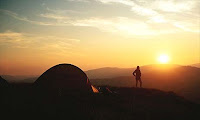'Getting away from it all' is often difficult in the fast paced hedonistic world we all inhabit. Getting outdoors to the campsite is often the first port of call for many families and groups looking to get away from the urban haze, but a lot of people are now turning to Wild Camping, to really immerse themselves in their surroundings.
Wild Camping might not be such a family orientated pursuit, which is why it may appeal to lone campers or smaller groups who want to get away from the usual hubbub of the campsite, no mod cons, no screaming children et al.
The main concern on the mind of Wild Campers is exactly where they can pitch and set up camp. It can be recommended to make a polite request to the landowner first, but this process can be a little impractical. The likelihood of being chased off the land by a shotgun wielding owner is fairly remote, however it is best to take a few precautions to make sure you don't disturb anyone or anything. The worst that can happen is to be told to move on. First up, the phrase "pitch late, leave early" comes into play, following this mantra will ensure you stay out of the way where possible, without disturbing the land too much. Pitching somewhere fairly secluded and out of sight is also to be recommended. It sort of goes without saying but pitching near livestock is best avoided as is starting an open fire.
The idea of Wild Camping is to immerse yourself in your chosen environment, so traveling light is usually the best way forward. Before packing just ask yourself "Do I really need this?" and you should be pretty much set.
Here's five Wild Camping Top Tips, courtesy of TGO Magazine...
1) Make a checklist of gear so you don't forget anything. This should include small items like a lighter, matches or fire steel for lighting your stove and easily mislaid components of other items like tent pegs. Don't just write down 'stove' and 'tent'!
2) Carry a small repair kit so you can mend punctures in sleeping mats, blocked stoves, torn sleeping bags and any other items that get accidentally damaged.
3) Check potential sites for sharp twigs, pointed stones, spiky pine cones and other items that might pierce your groundsheet, and move them away.
4) In windy weather look for shelter from banks, trees, rocks or other windbreaks. Don't camp in hollows that could flood or under trees with dead branches though.
5) Carry large collapsible water containers so only one trip to a water source is needed. This means you don't have to venture out into storms and ensures you stay hydrated.
If you fancy trying a spot of Wild Camping, we've got all the gear for you; lightweight tents, stoves, sleeping bags and of course scrummy food to keep your energy up for a days exploring!



No comments:
Post a Comment